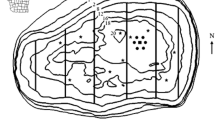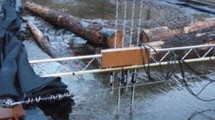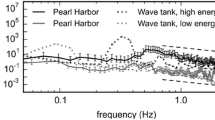Abstract
Antarctic krill, Euphausia superba, are critical components of the Antarctic food web as well as important targets for conservation and management. Krill behavior has important effects on demographic properties and aggregation characteristics, but remains incompletely known. Krill clearly respond to different environmental stimuli such as light, flow and chemicals, but few studies have quantified these behaviors. We examined the behavior of krill in well-quantified current speeds in a laboratory flume and examined interactions of phytoplankton odor and flow. Krill are sensitive to flow speeds as low as 1 mm s−1, and flow polarizes krill swimming and orientation in the up-current direction. Phytoplankton odor increases the sensitivity of krill to flow, and induces area-restricted search behaviors that presumably allow krill to exploit food patches efficiently. The ability to quantify krill behavior could have important consequences for understanding demographic processes and the properties of krill aggregations.





Similar content being viewed by others

References
Abrahamsen MB, Browman HI, Fields DM, Skiftesvik AB (2010) The three-dimensional prey field of the northern krill, Meganyctiphanes norvegica, and the escape responses of their copepod prey. Mar Biol 157:1251–1258
Atkinson A, Hill SL, Barange M, Pakhomov EA, Raubenheimer D, Schmidt K, Reiss C (2014) Sardine cycles, krill declines, and locust plagues: revisiting food webs. Trends Ecol Evol 29:309–316
Bernard KS, Steinberg DK (2013) Krill biomass and aggregation structure in relation to tidal cycle in a penguin foraging region off the Western Antarctic Peninsula. ICES J Mar Sci 70:834–884
Cox MJ, Warren D, Demer DA, Cutter GR, Brierley AS (2010) Three-dimensional observations of swarms of Antarctic krill (Euphausia superba) made using a multi-beam echosounder. Deep Sea Res Part II: Topical Studies in Oceanography 57:508–518
Cox MJ, Watkins JL, ReidK Brierley AS (2011) Spatial and temporal variability in the structure of aggregations of Antarctic krill (Euphausia superba) around South Georgia, 1997–1999. ICES J Mar Sci 68:489–498
Cresswell KA, Tarling GA, Burrows MT (2007) Behaviour affects local-scale distributions of Antarctic krill around South Georgia. Mar Ecol Progr Series 343:193–206
Cresswell KA, Tarling GA, Thorpe SE, Burrows MT, Wiedenmann J, Mangel M (2009) Diel vertical migration of Antarctic krill (Euphausia superba) is flexible during advection across the Scotia Sea. J Plankton Res 31:1265–1281
Fields DM, Yen J (1997) The escape behavior of marine copepods in response to a quantifiable fluid mechanical disturbance. J Plankton Res 19:1289–1304
Fields DM, Shema SD, Browman HI, Browne TQ, Skiftesvik AB (2012) Light primes the escape response of the calanoid copepod, Calanus finmarchicus. PLoS One. https://doi.org/10.1371/journal.pone.0039594
Gerritsen J, Strickler JR (1977) Encounter probabilities and community structure in zooplankton: a mathematical model. Fish Res Board 34:73–82
Gill CW (1986) Suspected mechanosensory and chemosensory structures of Temora longicornis (Copepoda, Calanoida). Mar Biol 93:449–457
Haberman KL, Quetin LB, Ross RM (2003) Diet of the Antarctic krill (Euphausia superba Dana): I. Comparisons of grazing on Phaeocystis antarctica (Karsten) and Thalassiosira antarctica (Comber). J Exp Mar Biol Ecol 283:79–95
Hamner WM, Hamner PP (2000) Behavior of Antarctic krill (Euphausia superba): Schooling, foraging, and antipredatory behavior. Can J Fish Aquatic Sci 57:192–202
Hamner WM, Hamner PP, Strand SW, Gilmer RW (1983) Behavior of Antarctic Krill, Euphausia superba: Chemoreception, feeding, schooling, and molting. Science 220:433
Kavanaugh MT, Abdala FN, Ducklow H, Glover D, Fraser W, Martinson D, Stammerjohn S, Schofield O, Doney SC (2015) Effect of continental shelf canyons on phytoplankton biomass and community composition along the western Antarctic Peninsula. Mar Ecol Prog Ser 534:11–26
Kawaguchi S, King R, Meijers R, Osborn JE, Swadling KM, Ritz DA, Nicol S (2010) An experimental aquarium for observing the schooling behaviour of Antarctic krill (Euphausia superba). Deep Sea Res II 57:683–692
Kils O (1981) The swimming behaviour, swimming performance and energy balance of Antarctic krill, Euphausia superba. BIOMASS Scientific Series 3:1–21
Kohut JT, Winsor P, Statscewich H, Oliver MJ, Fredj E, Couto N, Bernard K, Fraser W (2018) Variability in summer surface residence time within a West Antarctic Peninsula biological hotspot. Phil Trans R Soc A. https://doi.org/10.1098/rsta.2017.0165
Lawson GL, Wiebe PH, Ashjian CJ, Stanton TK (2008) Euphausiid distribution along the Western Antarctic Peninsula—Part B: Distribution of euphausiid aggregations and biomass, and associations with environmental features. Deep Sea Res II 55:432–454
Marr J (1962) The natural history and geography of the Antarctic krill (Euphausia superba). Discov Rep 82:33–464
Newman SJ, Ritz D, Nicol S (2003) Behavioural reactions of Antarctic krill (Euphausia superba Dana) to ultraviolet and photosynthetically active radiation. J Exp Mar Biol Ecol 297:203–217
Nicol S (2003) Living krill, zooplankton and experimental investigations: a discourse on the role of krill and their experimental study in marine ecology. Mar Freshwater Behav Physiol 36:191–205
O’Brien DP (1987) Description of escape responses of krill (Crustacea: Euphausiacea), with particular reference to swarming behavior and the size and proximity of the predator. J Crustacean Biol 7:449–457
Patria MP, Wiese K (2004) Swimming in formation in krill (Euphausiacea), a hypothesis: dynamics of the flow field, properties of antennular sensor systems and a sensory–motor link. J Plankton Res 26:1315–1325
Price HJ (1989) Swimming behavior of krill in response to algal patches: a mesocosm study. Limnol Oceanogr 34:649–659
Quetin LB, Ross RM, Clarke A (1994) Krill energetics: seasonal and environmental aspects of the physiology of Euphausia superba, in Southern Ocean Ecology. In: El-Sayed SZ (ed) The BIOMASS perspective. Cambridge University Press, Cambridge, pp 165–184
Santora JA, Sydeman WJ, Schroeder ID, Reiss CS, Wells BK, Field JC, Loeb VJ (2012) Krill space: a comparative assessment of mesoscale structuring in polar and temperate marine ecosystems. ICES J Mar Sci 69:1317–1327
Strand SW, Hamner WM (1990) Schooling behavior of Antarctic krill (Euphausia superba) in laboratory aquaria: reactions to chemical and visual stimuli. Mar Biol 106:355–359
Swadling KM, Ritz DA, Nicol S, Osborn JE, Gurney LJ (2005) Respiration rate and cost of swimming for Antarctic krill, Euphausia superba, in large groups in the laboratory. Mar Biol 146:1169–1175
Tarling GA, Thorpe SE (2014) Instantaneous movement of krill swarms in the Antarctic Circumpolar Current. Limnol Oceanogr 59:872–886
Tiselius P (1992) Behavior of Acartia tonsa in patchy food environments. Limnol Oceanogr 37:1640–1651
Tyson LH (2008) Software techniques for two- and three-dimensional kinematic measurements of biological and biomimetic systems. Bioinspir Biomim 3:034001
Veit RR, Silverman ED, Everson I (1993) Aggregation patterns of pelagic predators and their principal prey, Antarctic krill, near South Georgia. J Animal Ecol 62:551–564
Willis J (2014) Whales maintained a high abundance of krill; both are ecosystem engineers in the Southern Ocean. Mar Ecol Prog Ser 513:51–69
Woodson CB, Webster DR, Weissburg MJ, Yen J (2005) Response of copepods to physical gradients associated with structure in the ocean. Limnol Oceanogr 50:1552–1564
Acknowledgements
DMF was supported by NSF Award # 1537579, and JY by NSF Award PLR-1246296. This work would not have been possible without the outstanding efforts of the crew of the RV Laurence M. Gould and the staff at Palmer Station. Their support, as well as that of the United States Antarctic Program is gratefully acknowledged. Madison Luker assisted in analyzing krill kinematics, and Dr. Jun Zhang designed and fabricated the flume.
Author information
Authors and Affiliations
Corresponding author
Ethics declarations
Conflict of interest
The authors declare they have no conflicts of interest regarding this work.
Additional information
Publisher's Note Springer Nature remains neutral with regard to jurisdictional claims in published maps and institutional affiliations
Rights and permissions
About this article
Cite this article
Weissburg, M.J., Yen, J. & Fields, D.M. Phytoplankton odor modifies the response of Euphausia superba to flow. Polar Biol 42, 509–516 (2019). https://doi.org/10.1007/s00300-018-02440-w
Received:
Revised:
Accepted:
Published:
Issue Date:
DOI: https://doi.org/10.1007/s00300-018-02440-w



